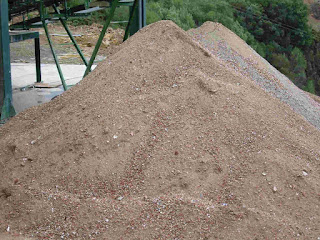After completion of civil engineering most of the students go on site to grab some practical knowledge. But many times he faces some confusion due to new terms he hear on sites which he was not yet heared in theory knowledge in College. Some of the terms from them i have to discuss hear to refuse the confusion of fresher's . So let's start.
Bajari Glass - Pin Headed glassBrass - Per 100 units of work
Butt finishing - Finishing at the Junction of Skirting and wall Plaster
Chameli glass - Glass with chameli flower design pattern
Chavi / Chawis - Wooden section
Chhara - Unfinished layer of cement mortar plaster (Thick)
Chhalan or Chalni - Sieving screen
Chharpatti / Column Patti - Thin Hold fast Strip
Chatt - Unfinished layer of cement mortar plaster (Thin)
Chikana stone - Stone used for Mirror Finishing
Chicken Mesh - Hexagonal Wire Nettings
Chinni - Chisel
Chuna Fakki - Lime Powder
Chuna Ghani - Lime Morter Mill
Depo - The heap of sand and metal (aggregates) or Only sand Required for one bag of Cement mix
Dhar Patti - Plank Provided for Edge
Dhummas - Wooden Log for Ramming
Donga - White wash
Drum - Barrel
Emery Stone - Stone used for Marble Polishing
Fakki - Line Powder
Falli - Wooden Plank
Farma - Measuring Box
Farma
Hatoda - Hamme
Chavi / Chawis - Wooden section
Chhara - Unfinished layer of cement mortar plaster (Thick)
Chhalan or Chalni - Sieving screen
Chharpatti / Column Patti - Thin Hold fast Strip
Chatt - Unfinished layer of cement mortar plaster (Thin)
Chikana stone - Stone used for Mirror Finishing
Chicken Mesh - Hexagonal Wire Nettings
Chinni - Chisel
Chuna Fakki - Lime Powder
Chuna Ghani - Lime Morter Mill
Depo - The heap of sand and metal (aggregates) or Only sand Required for one bag of Cement mix
Depo of sand
Dhar - EdgeDhar Patti - Plank Provided for Edge
Dhummas - Wooden Log for Ramming
Donga - White wash
Drum - Barrel
Emery Stone - Stone used for Marble Polishing
Fakki - Line Powder
Falli - Wooden Plank
Farma - Measuring Box
Farma
Gattu - Concrete Block
Gattu Brick - 15cm Thick Brick
Geru - Red Colour Powder
Ghabhadi / Chabadi / Gabadi - Hollow space / hole
Ghadai - Preparation and cleaning of surface
Ghamela - Mortar Pan
Ghishi - Groove
Ghishi Patti - Batten for Groove Making
Ghotai - Smooth Finish
Gutav - Interlocking / Bonding
Gutti - Joggle to Reinforcement
Habak - White Zink PasteHatoda - Hamme
Jad - Butt/Unfinished Gap between plaster and skirting
Jali /Jalli - Mesh
Kaccha - Inferior
Kani - Projected Edge of plaster / water proofing
Kapchi - Stone chips
Kathya - Thin Rope made from coconut fibre / coir
Kau - Red colour powder
Kavadi - China Mosaic Pieces
Khachara level - Flooring Level Marked on door frame
Khadi Maal - 20 mm Metal with Rich Mortar used for packing the gap between the junctions of wall/beam,column
khangar - Over Burnt Bricks
Khara stone - Rough Stone used for Polishing
Khaswa - Very Fine Sand
Khat - Manure
Kitchen Otta - Kitchen Platform
Kodi - On Edge
Lambi - Putty
Lapha - Piece of Plank
Level Batli - Spirit level
Line Dori - String / Marking string
Machan - Bedding (C.M/L.M)
Mandap / Pandal - Temporary shed
M.S Ghodi - M.S chair
M.S. chair
Mukadam - Leader of Labour Gang
Mundha - Wooden Ballie
Narmada - Flat brush used for smooth Polishing of Marble,Kotah etc
Nayla - Small Trowel with Pointed Edge
Pachar - Wedge
Pahad - Scaffolding
Pani Patti - Drip Mould
Panja - Form Made out of 6mm dia M.S bars
Parrdi - Thin RCC wall
Patli - RCC Band
Patra - Thin Sheet
Patta - Band
Patti - Strip / Batten
Patti level - Full Level
Perni - Masonary line out
Phawda - Spade
Polish Patra - Metal Float
Poyata - Type of garden soil
Pucca Brick - Well burnt brick
Rabbit - Debris
Rala - Thick Cement slurry
Randha - Wooden Float
Randha
Rejas - Small cut pieces / scrap of reinforcement steel
Salai - Pieces of MS Bars
Shinkjas / Shikanja - MS clamps for shuttering
Shingle - very coarse sand
If you want more theory / practical knowledge in civil engineering join this group now👉👉https://chat.whatsapp.com/LWik92DzeBXC9Nhiwd70Wi
Tacha - Hacking Pick
Tadi Patti - Locking Patti
Tang side - Suspended side
Tappa - Step (Tread and riser)
Thapi - Trowel
Thiyyas - Level Dots
Thokla Bricks - 15 cm Bricks
Tikav - Pick axe
Tapani / Tipni - Small wooded float
Tomato glass - Glass with Tomato design Pattern
Topi - Piece of plank fixed on column to support beam bottom
Tukada - Pieces
Umara Patti - Threshold
Wassa - Wooden Prop
Wata - Rounding in Plaster or Waterproofing
Wooden Farma - Wooden Measuring Box
Wooden Patti - Wooden Batten
Zula /zoola - Swing made from wooden plank & Rope for outside work of buildings at Heights
Like share and comment your questions and review in comment box.
If you have any dout feel free to ask .
Thank you .
Keywords- # Civil engineering# site # practical# construction technique#








